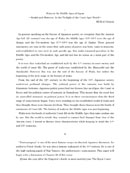「中世の日本における和歌 ―兼好と正徹:王朝時代の残照の中で―」 村尾 誠一
"Waka in the Middle Age of Japan -KENKO and SHOUTETSU,
In the Twilight of the Court Ages World-" MURAO Seiichi
英文要旨
 In general speaking on the history of Japanese poetry, we recognize that the Ancient Age (till 12th century) was the age of Waka, the Middle Ages (13th-16th) were the age of Renga, and the Pre-modern Age (17th-19th) was the age of Haikai. These general statements are true in the sense that each genre of poetry was born, came to maturity, and established its own style in each specific age. But waka remained prevalent in the Middle Ages and the Pre-modern Age, and did not lose its status as a main part of the poetry.
In general speaking on the history of Japanese poetry, we recognize that the Ancient Age (till 12th century) was the age of Waka, the Middle Ages (13th-16th) were the age of Renga, and the Pre-modern Age (17th-19th) was the age of Haikai. These general statements are true in the sense that each genre of poetry was born, came to maturity, and established its own style in each specific age. But waka remained prevalent in the Middle Ages and the Pre-modern Age, and did not lose its status as a main part of the poetry.
It is true that waka had an established style by the 11th century in court society and the world of court life. The genre of waka was established by the Manyoshū and the Sandaishū. However this was not the end of the history of Waka, but rather the beginning of the next stage in the history of waka.
 From the end of the 12th century to the beginning of the 13th, Japanese society underwent profound changes. The political power of the samurai was build by Minamoto Yoritomo. Japanese politic power had two focuses like an ellipse, the Court in Kyoto and the political center of samurai in Kamakura. This meant that the court lost its unrivalled monopoly on political power. It is in these circumstances that the third stage of waka history began. Poets were standing on the established world of waka and they thought those were classics for them. They thought these classics were the bonds of continence of Court life. The history of waka in the Middle Ages was just beginning.。
From the end of the 12th century to the beginning of the 13th, Japanese society underwent profound changes. The political power of the samurai was build by Minamoto Yoritomo. Japanese politic power had two focuses like an ellipse, the Court in Kyoto and the political center of samurai in Kamakura. This meant that the court lost its unrivalled monopoly on political power. It is in these circumstances that the third stage of waka history began. Poets were standing on the established world of waka and they thought those were classics for them. They thought these classics were the bonds of continence of Court life. The history of waka in the Middle Ages was just beginning.。
 Waka were the bonds of authentic Court life in the Middle Ages that came undone one by one. But the world to which they wanted to connect had changed from that of the Ancient court. I intend to discuss these characteristics while keeping in mind the 14th and 15th centuries.
Waka were the bonds of authentic Court life in the Middle Ages that came undone one by one. But the world to which they wanted to connect had changed from that of the Ancient court. I intend to discuss these characteristics while keeping in mind the 14th and 15th centuries.
詳しくは英語本文(PDF)をご覧ください。
 |
||
| 英語本文(PDF) |